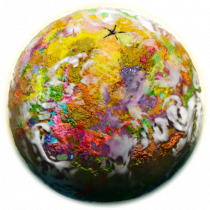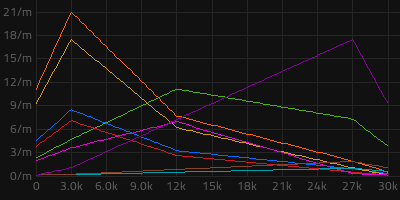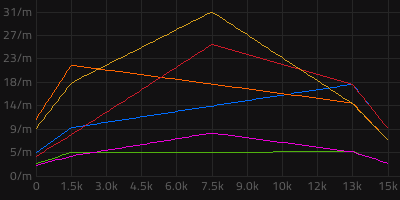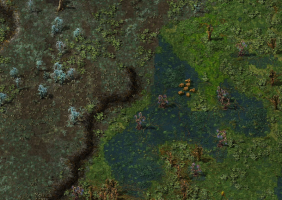Gleba: Difference between revisions
ACryInShame (talk | contribs) m got rid of extra spacing |
ACryInShame (talk | contribs) |
||
| Line 206: | Line 206: | ||
* {{NavboxIconLink|Aquilo}} {{SA}} | * {{NavboxIconLink|Aquilo}} {{SA}} | ||
* {{NavboxIconLink|Fulgora}}{{SA}} | * {{NavboxIconLink|Fulgora}}{{SA}} | ||
* {{NavboxIconLink|Nauvis}} | |||
* {{NavboxIconLink|Vulcanus}} {{SA}} | * {{NavboxIconLink|Vulcanus}} {{SA}} | ||
Revision as of 18:59, 8 November 2024
| This article is a stub, and not comprehensive. |
|---|
| You can help this wiki by expanding it. |
![]() Space Age expansion exclusive feature.
Space Age expansion exclusive feature.

Gleba is a moist, agricultural planet with fungal hills and swampy lowlands.
It is home to the pentapods![]() , which are spider-like, enemies who are attracted to the scent of biological processing, similar to the way that Nauvis creatures negatively respond to pollution. One of the most prominent traits of Gleba is that nearly everything takes a biological form.
, which are spider-like, enemies who are attracted to the scent of biological processing, similar to the way that Nauvis creatures negatively respond to pollution. One of the most prominent traits of Gleba is that nearly everything takes a biological form.
Required Research
Exclusive Items
The following items are unlocked on Gleba:
Space routes
Gleba is connected to 4 other planets: Aquilo, Fulgora![]() , Nauvis, and Vulcanus.
, Nauvis, and Vulcanus.
| Planet | Distance (KM) |
|---|---|
| Aquilo |
30,000 |
| Fulgora |
15,000 |
| Nauvis | 15,000 |
| Vulcanus |
15,000 |
Asteroid rate graphs:
-- This is a space holder for when the Gleba graphs are added --
 Space route from Gleba to Aquilo |
 Space route from Gleba to Fulgora |
File:Asteroid chart Gleba Nauvis.png Space route from Gleba to Nauvis |
File:Asteroid chart Gleba Vulcanus.png Space route from Gleba to Vulcanus |
Graph legend:
| Asteroid type | Chunk | Medium |
|---|---|---|
| ● Blue | ● Red | |
| ● Orange | ● Yellow | |
| ● Green | ● Magenta |
Orbit
Properties
| Property | Value |
|---|---|
| Solar Power | 200% |
| Asteroid Type | Spawn Ratio |
|---|---|
| Metallic asteroid chunk |
2 |
| Carbonic asteroid chunk |
5 |
| Oxide asteroid chunk |
1 |
| Promethium asteroid chunk |
0 |
| Asteroid Size | Spawn % |
|---|---|
| Chunk | .30 |
| Medium | .25 |
| Big | 0 |
| Huge | 0 |
Note:
- Chunks spawn at Nauvis at 1.25%
- Huge Asteroids only spawn past Aquilo

Surface
Properties
| Property | Value |
|---|---|
| Pollutant Type | Spores |
| Day Night Cycle | 10 Minutes |
| Magnetic Field | 10 |
| Solar Power | 50% |
| Pressure | 2000 |
| Gravity | 20 |
Biomes
Gleba hosts multiple biomes.
Deep water An impassable
Shallows A walkable murky water, filled with watercanes. Green lowlands
Red lowlands
Green midlands
Red midlands
Highlands
Mechanics
Spoilage
Most biological products on Gleba are "spoilable". A spoilable item has an inherent timer attached to it, which begins at the item's creation. When the timer reaches 0, the item is transformed into spoilage,![]() with a few exceptions. This process is inevitable and cannot be stopped.
with a few exceptions. This process is inevitable and cannot be stopped.
The exact time differs per item, ranging anywhere from a few minutes to 2 hours. This means that item throughput is more important than ever on Gleba, and buffering a large stockpile is ineffective, as items can spoil within containers.
When crafting with spoilable items, the final product will inherit the freshness value of the ingredients. The three exceptions are iron and copper bacteria cultivation, pentapod eggs and fish breeding, whose recipes will always result in a 100% fresh product, regardless of the freshness of the ingredients.
When crafting with two different spoilable items of different freshness values, like in the agricultural science pack![]() and bioflux
and bioflux![]() recipes, the final product's freshness is determined by the following formula
recipes, the final product's freshness is determined by the following formula
- (Larger freshness/2) + (Smaller freshness/1.5) = Final freshness value
The agricultural science pack does spoil, which will gradually decrease its research value, so the player is incentivized to build a fast space platform to bring them back to Nauvis.
Spoilable items are used as ingredients in a few non-spoilable items, such as the biochamber![]() . In these, the freshness value of the ingredients do not matter in the product being produced.
. In these, the freshness value of the ingredients do not matter in the product being produced.
| Item | Time | Special effect on spoiling |
|---|---|---|
| Agricultural science pack | 1 hour | |
| Biter egg | 30 minute | Spawns a Big Biter |
| Bioflux | 2 hours | |
| Copper bacteria | 1 minute | Turns into copper ore |
| Raw fish | 2 hours, 5 minutes, 50 seconds | |
| Iron bacteria | 1 minute | Turns into iron ore |
| Jelly | 4 minutes | |
| Jellynut | 1 hour | |
| Nutrients | 5 minutes | |
| Pentapod egg | 15 minutes | Spawns a wriggler |
| Yumako | 1 hour | |
| Yumako mash | 3 minutes |
See also
Gallery
-
Example landscape of Gleba.
Trivia
- In biology, a gleba is a fleshy, spore-filled inner mass of some fungi like the puffball.
- During development, Gleba was once named Bacchus, after the Roman god of fertility, orchards, and vegetation.
